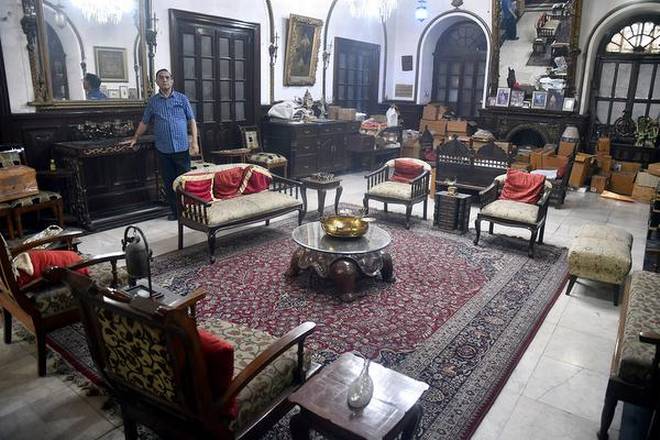NEW DELHI :

Chunnamal Haveli carries many fascinating tales about the change in lifestyle and architecture of Delhi after 1857
The redone arterial road of Shahjahanabad has attracted attention towards conserving the historical architectural facades of several buildings along the stretch that connects Sri Digambar Lal Jain Mandir to Fatehpuri Masjid.
Along with the facades of heritage homes, there is an urgent need to conserve family and lifestyle histories as part of intangible heritage. In this regard, Lala Chunnamal, the largest living mansion on the iconic street, illustrates a fascinating account.
The Chandni Chowk and surrounding lanes and by-lanes represent, along with several other layers, the lifestyles of the landed elites, merchant classes and evolving middle-class professionals. Several mansions reflect the Mughal period and the British rule in Delhi. Many of these families aligned with the Mughals for practical reasons and changed their allegiance to the new British masters, impacting the nature of lifestyles and architecture.
‘Lalacracy’ era
The period and predominance of merchants and the new landed class in different cities have been described as ‘Lalacracy’ by eminent historian Narayani Gupta in Delhi Between Two Empires 1803-1931: Society, Government and Urban Growth.
Built in 1864, the Chunnamal Haveli continues to be used by Lala’s sixth-generation descendant Anil Pershad and his family. A successful trader, Chunnamal was primarily a cloth merchant (indicative of the exact location of the house in Katra Neel) and had significant trade links in Kolkata, and a summer home in Shimla.
Soon after 1857, Lala Chunnamal bought a large part of the present-day Chandni Chowk and the Fatehpuri Masjid in an auction for a pittance. “Most mosques were closed for a couple of years after the rebellion; many Muslims fled the city. My grandfather, a practical businessman, watched out for the shops around the mosque. The family-owned shops built Shivalayas, dharamshalas and drinking water kiosks in Shahjahanabad, Mehrauli, Nangloi, etc. So why could he not manage a mosque,” remarks Pershad.
He says the family owned the shops from the erstwhile Majestic cinema to the Baptist Church and the area behind the present Bhagirath Palace. “After some years, the family returned the Fatehpuri mosque to the Muslim community. The British recognised the gesture and gave us some villages as a gift,” adds Pershad.
Unlike many others, knowingly or inadvertently, the Chunnamal family saved a mosque from being demolished or turned into a bakery shop or a garrison for the armed forces when the British took over after the First War of Independence.
The grand mansion integrated sturdy cast-iron balconies and spun spiral staircases, wooden Venetian windows, and used stained glass. The interiors characterise Indo-Western aesthetics decor like the famed Osler glassware chandeliers for candles, Belgian mirrors, European furniture, clocks, telephones, fireplaces, and even maintenance tools for the fireplace. Sophisticated crafts to embellish the interiors include clay tiles from Sindh that provide a carpet look. The gold-plated stucco work in the ceiling is offset with natural indigo. The roof is decorated with ceiling cloth that displays the best of Indian crafts.
Ice emerged as a much-wanted product since the British required it to cool their drinks and water. Chunnamal owned the famous Baraf Khana or the ice-making unit in North Delhi, the Old Subzi Mandi and Pul Bangash. “Twice-elected to the Municipal Corporation, he was one of the few Indians who were granted membership of the exclusive Delhi Gymkhana Club during the British days,” remembers Pershad. He was also a member of the Roshanara Club, Delhi Race Club and the National Sports Club.
High life
The Chunnamal family bred horses, some were housed in their home stables, while others were in the Delhi Race Club. Members of the family rode horses from Chandni Chowk to New Delhi. A special place for the family was their Rambagh Garden near the Roshanara Club. Viceroys visited, Indira Gandhi came to dine, and the family participated in horse races, including winning the Aminabad horseshow in Lucknow. Some members of the family even came to be members of the secret society of the Freemasons, who continued to meet in the Qudsia Bagh in Civil Lines.
The courtyard hosted gatherings of courtesans, which women of the family watched from behind the bamboo curtains. Pershad’s daughter-in-law Swetcha Pershad described how female service providers like washerwomen and barbers transmitted ‘news’ from one zenana or women quarters to other havelis. The hustle-bustle of the home saw the women under the guidance of a Parsi governess acquire skills in cooking western dishes, accessing recipes from the Woman & Home magazine launched in the 1920s.
Organisations like the UNESCO and urban governments in different parts of the world attempt to formulate policies to balance development with preserving historic urban landscapes. They involve stakeholders, incentivise owners of heritage homes to retain facades while making the inside of dwellings modern.
The remaking of the Chandni Chowk requires holistic policies and their execution before many of more than 30 private-public owned heritage buildings are replaced by buildings that do not go with the character of the historical landscape.
(The author is an expert on cultural heritage)
source: http://www.thehindu.com / The Hindu / Home> News> Cities / by Navina Jafa / October 10th, 2021








